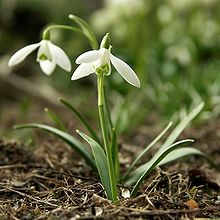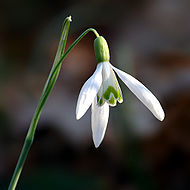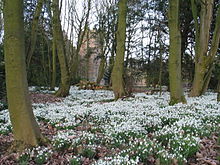- Galanthus
-
"Snowdrop" redirects here. For other uses, see Snowdrop (disambiguation).
Galanthus 
Common Snowdrop Scientific classification 
Kingdom: Plantae clade: Angiosperms clade: Monocots Order: Asparagales Family: Amaryllidaceae Subfamily: Amaryllidoideae Genus: Galanthus
L.Species G. alpinus
G. angustifolius
G. cilicicus
G. fosteri
G. elwesii
G. gracilis
G. ikariae
G. koenenianus
G. krasnovii
G. lagodechianus
G. nivalis
G. peshmenii
G. platyphyllus
G. plicatus
G. reginae-olgae
G. rizehensis
G. transcaucasicus
G. trojanus
G. woronowiiGalanthus (Snowdrop; Greek gála "milk", ánthos "flower") is a small genus of about 20 species of bulbous herbaceous plants in the Amaryllis family, subfamily Amaryllidoideae.[1] Most flower in winter, before the vernal equinox (21 March in the Northern Hemisphere), but certain species flower in early spring and late autumn.
Snowdrops are sometimes confused with their relatives, snowflakes, which are Leucojum and Acis species; see below.
Contents
Ecology
Distribution
Galanthus nivalis is the best-known and most widespread representative of the genus Galanthus. It is native to a large area of Europe, stretching from the Pyrenees in the west, through France and Germany to Poland in the north, Italy, Northern Greece, Ukraine, and European Turkey. It has been introduced and is widely naturalised elsewhere.[2] Although it is often thought of as a British native wild flower, or to have been brought to the British Isles by the Romans, it was probably introduced around the early sixteenth century and is currently not a protected species in the UK.[3]
Most other Galanthus species are from the eastern Mediterranean, though several are found in southern Russia, Georgia and Azerbaijan.[4] Galanthus fosteri comes from Jordan, Lebanon, Syria, Turkey and maybe Israel.[5]
Conservation
Some snowdrop species are threatened in their wild habitats, and in most countries it is now illegal to collect bulbs from the wild. Under CITES regulations, international trade in any quantity of Galanthus, whether bulbs, live plants or even dead ones, is illegal without a CITES permit. This applies to hybrids and named cultivars as well as species. CITES does, however, allow a limited trade in wild-collected bulbs of just three species (G. nivalis, G, elwesii and G. woronowii) from Turkey and Georgia.[6]
Description
All species of Galanthus are perennial, herbaceous plants which grow from bulbs. Each bulb generally produces just two or three linear leaves and an erect, leafless scape (flowering stalk), which bears at the top a pair of bract-like spathe valves joined by a papery membrane. From between them emerges a solitary, pendulous, bell-shaped white flower, held on a slender pedicel. The flower has no petals: it consists of six tepals, the outer three being larger and more convex than the inner series. The six anthers open by pores or short slits. The ovary is three-celled, ripening into a three-celled capsule. Each whitish seed has a small, fleshy tail (elaiosome) containing substances attractive to ants which distribute the seeds.[7] The leaves die back a few weeks after the flowers have faded.
The inner flower segments are usually marked with a green, or greenish-yellow, bridge-shaped mark over the small "sinus" (notch) at the tip of each tepal.
An important feature which helps to distinguish between species (and to help to determine the parentage of hybrids) is their "vernation" (the arrangement of the emerging leaves relative to each other). This can be "applanate", "supervolute" or "explicative". In applanate vernation the two leaf blades are pressed flat to each other within the bud and as they emerge; explicative leaves are also pressed flat against each other, but the edges of the leaves are folded back or sometimes rolled; in supervolute plants one leaf is tightly clasped around the other within the bud and generally remains at the point where the leaves emerge from the soil.[8]
Cultivation and uses
Propagation
Propagation is by offset bulbs, either by careful division of clumps in full growth ("in the green"), or removed when the plants are dormant, immediately after the leaves have withered; or by seeds sown either when ripe, or in spring. Professional growers and keen amateurs also use such methods as "twin-scaling" to increase the stock of choice cultivars quickly.
Active substances
It was suggested by Duvoisin in 1983 that the mysterious magical herb moly that appears in Homer's Odyssey is actually snowdrop. An active substance in snowdrop is called galantamine, which, as anticholinesterase, could have acted as an antidote to Circe's poisons.[9] Galantamine (or galanthamine) can be helpful in the treatment of Alzheimer's disease, though it is not a cure; the substance also occurs naturally in daffodils and other narcissi.
Snowdrop gardens
Celebrated as a sign of spring, snowdrops can form impressive carpets of white in areas where they are native or have been naturalised. These displays may attract large numbers of sightseers. Several gardens open specially in February for visitors to admire the flowers. Sixty gardens took part in Scotland's first Snowdrop Festival (1 Feb–11 March 2007).[10] Several gardens in England open during snowdrop season for the National Gardens Scheme (NGS) (see their website for up-to-date details).
There are a number of snowdrop gardens in England, Scotland, and Ireland.[11]
England
- Anglesey Abbey, Lode, Cambridgeshire
- Bank Hall, Bretherton, Lancashire
A snowdrop carpet at Bank Hall, Feb 2009

- Benington Lordship, Hertfordshire
- Brandy Mount, New Alresford, Hampshire (NCCPG National Plant Collection of Snowdrops) (NGS)
- Chippenham Park, Newmarket, Cambridge, Cambridgeshire
- Colesbourne Park, Gloucestershire
- East Lambrook Manor, Somerset (NGS)
- Easton Lodge, near Little Easton, Essex
- Easton Walled Gardens, near Grantham, Lincolnshire
- Felley Priory, Nottinghamshire
- Hanwell Community Observatory, Banbury, Oxfordshire
- Hodsock Priory, Nottinghamshire
- Ickworth House, Park and Gardens, Horringer, Bury St Edmunds, Suffolk
- Kingston Lacey, Dorset
- Moggerhanger House, Bedfordshire
- Painswick Rococo Gardens, Gloucestershire
- Pembury House, Clayton, West Sussex (NGS)
- Rodmarton Manor, Gloucestershire
- Walsingham, Norfolk
- Welford Park, Newbury, Berkshire
Scotland
- Cambo Estate, Fife
- Finlaystone, Renfrewshire
- Gagie House, by Dundee
Ireland
- Mark Smyth's Garden in Antrim
- Primrose Hill, Lucan, County Dublin, Ireland [12]
- Altamont Garden,Tullow,County Carlow [1][2]
Subdivisions
Species
Notable species include:
- Common snowdrop, Galanthus nivalis, grows to around 7–15 cm tall, flowering between January and April in the northern temperate zone (January–May in the wild). Applanate vernation[13]
- Crimean snowdrop, Galanthus plicatus, 30 cm tall, flowering January/March, white flowers, with broad leaves folded back at the edges (explicative vernation)
- Giant snowdrop, Galanthus elwesii, a native of the Levant, 23 cm tall, flowering January/February, with large flowers, the three inner segments of which often have a much larger and more conspicuous green blotch (or blotches) than the more common kinds; supervolute vernation
- Galanthus reginae-olgae, from Greece and Sicily, is quite similar in appearance to G. nivalis, but flowers in autumn before the leaves appear. The leaves, which appear in the spring, have a characteristic white stripe on their upper side; applanate vernation
- subsp. vernalis, from Sicily, northern Greece and the south of former Yugoslavia, blooms at the end of the winter with developed young leaves and is thus easily confused with G. nivalis.
Cultivars
There are numerous single- and double-flowered cultivars of Galanthus nivalis, and also of several other Galanthus species, particularly G. plicatus and G. elwesii. There are also many hybrids between these and other species (there are more than 500 cultivars described in Bishop, Davis & Grimshaw's book, plus lists of many cultivars that have now been lost, and others not seen by the authors). They differ particularly in the size, shape and markings of the flower, the period of flowering, and other characteristics, mainly of interest to the keen (even fanatical) snowdrop collectors, known as "galanthophiles", who hold meetings where the scarcer cultivars change hands.[14] Double-flowered cultivars and forms, such as the extremely common Galanthus nivalis f. pleniflorus 'Flore Pleno', may be less attractive to some people but they can have greater visual impact in a garden setting.
A list of Irish cultivars can be found here [3]
Similar genera
Snowdrops are sometimes confused with their relatives, snowflakes, Leucojum and Acis species. Leucojums are much larger and flower in spring (or early summer, depending on the species), with all six tepals in the flower being the same size, though it should be noted that some "poculiform" (goblet- or cup-shaped) Galanthus can have inner segments similar in shape and length to the outer ones.
Gallery
Media
- William Wordsworth, the Two-Part Ballad: "I began / My story early, feeling, as I fear, / The weakness of a human love for days / Disowned by memory, ere the birth of spring / Planting my snowdrops among winter snows" (ll. 445-59).
- Snowdrops feature in Seamus Heaney's poem Mid-term Break in the context of mourning a dead infant[15]
- "Snowdrop" is the subtitle of P. I. Tchaikovsky's piano piece, "April," in the piano cycle "The Seasons". The cycle contains 12 pieces, each is given the name of the month and a characteristic subtitle.
- In Neil Gaiman's novel Stardust, Dunstan Thorn and subsequently his son Tristran carry a glass snowdrop that chimes when held. The flower has a very small, but pivotal role in the story
- In the anime film Twelve Months (Sekai meisaku dowa mori wa ikiteiru in Japan), a greedy queen decrees that a basket of gold coins shall be rewarded to anyone who can bring her galanthus flowers in the dead of winter. A young girl named Anya is sent out during a snow storm by her cruel stepmother and find the spirits of the 12 months of the year, who take pity on her and not only save her from freezing to death, but make it possible for her to gather the flowers even in winter
- In the manga "Snow Drop" by Choi kyung-ah, Snow Drop was the name of the book that Yo So-Na's mother wrote. The name of the four characters in the manga was taken from that book: So-na, Hae-gi, Ko-mo, Gae-Ri. In this manga, snowdrop represented hope and warmth, because of the legend it carries in Korea
- "Snowdrops" was the nickname that the British people gave during the Second World War to the military police of the United States Army (who were stationed in the UK preparatory to the invasion of the continent) because they wore a white helmet, gloves, gaiters, and Sam Browne belt against their olive drab uniform
- In Jacqueline Carey's series of novels set in Terre d'Ange, snowdrops are distilled to create a beverage called joie that is drunk on the Longest Night (New Year's Eve). In Naamah's Kiss, one of the characters makes a tonic from snowdrops that acts as an aphrodisiac, and the protagonist Moirin takes snowdrops from Terre d'Ange (based on France) and plants them in a mountain in Ch'in (based on China).
- The short story The Snowdrop by Hans Christian Andersen follows the fate of a snowdrop from a bulb striving towards the light to a picked flower placed in a book of poetry. The poet, Ambrosius Stub, is compared to the flower—as a summer gauk (fool), born before his time.
- In the anime and manga series, "Shinkyoku Soukai Polyphonica," the White Series' protagonist is named "Snow Drop"
See also
References
Notes
- ^ Stevens, P.F. (2001 onwards), Angiosperm Phylogeny Website: Asparagales: Amaryllidoideae, http://www.mobot.org/mobot/research/apweb/orders/asparagalesweb.htm#AllAma
- ^ Davis, Aaron (1999). The genus Galanthus. Portland, Oregon: Timber Press. pp. 95–96. ISBN 0881924318.
- ^ Bishop, Matt; Aaron Davis, John Grimshaw (January 2002). SNOWDROPS A Monograph of Cultivated Galanthus. Griffin Press. pp. 17. ISBN 0954191609.
- ^ Bishop, Davis & Grimshaw (2002) pp17–57
- ^ Bishop, Davis & Grimshaw (2002) p40
- ^ Bishop, Davis & Grimshaw (2002) pp341–343
- ^ Bishop, Davis & Grimshaw (2002) p7
- ^ Bishop, Davis & Grimshaw (2002) pp1–2
- ^ Plaitakis A, Duvoisin RC, Homer's moly identified as Galanthus nivalis L.: physiologic antidote to stramonium poisoning. Clin Neuropharmacol. 1983 Mar; 6(1):1-5. Abstract
- ^ "VisitScotland.com: Snowdrop Festival". Archived from the original on 3 March 2007. http://web.archive.org/web/20070303112955/http://white.visitscotland.com/snowdrops/. Retrieved 11 March 2007.
- ^ "Great British Gardens: Snowdrops and Snowdrop Gardens 2007". http://www.greatbritishgardens.co.uk/snowdrops.htm. Retrieved 11 March 2007.
- ^ "RHS Event Finder: Snowdrops at Primrose Hill". Archived from the original on 29 August 2007. http://web.archive.org/web/20070829195329/http://www.rhs.org.uk/rhseventfinder/EventFinder2.asp?ID=5012379. Retrieved 11 March 2007.
- ^ Bishop, Davis & Grimshaw (2002) p17
- ^ Bishop, Davis & Grimshaw (2002) p329
- ^ Text of, and brief commentary on, Seamus Heaney's Mid-term Break
Further reading
- Aaron P Davis, The Genus Galanthus, A Botanical Magazine Monograph. Timber Press, Portland, Oregon (in association with the Royal Botanic Gardens, Kew) ISBN 0-88192-431-8
- Matt Bishop, Aaron Davis, John Grimshaw, SNOWDROPS A Monograph of Cultivated Galanthus, Griffin Press, January 2002 (ISBN 0-9541916-0-9)
- Gvaladze GE, Ultrastructural study of Embryo Sac of Galanthus nivalis L. in: Fertilization and embryogenesis, Bratislava, 1983
- Gvaladze GE, Akhalkatsi MSh, Ultrastructure of autumn and spring Embryo Sac of Galanthus nivalis L. in Annales Scientifiques de l'Universite de Reims Champagne-Ardenne et de l'A.R.E.R.S., 1988, Numero 23
- Stern F C, Snowdrops and Snowflakes – A study of the Genera Galanthus and Leucojum, The Royal Horticultural Society, 1956
External links
Categories:- Amaryllidaceae genera
- Flowers
- Medicinal plants
- Amaryllidoideae
Wikimedia Foundation. 2010.













